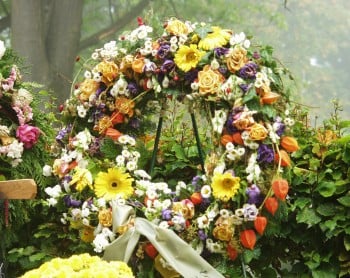Funeral Flower Terminology
Sending sympathy flowers to a family in mourning is a great way to show your support and contribute to the funeral arrangements. However, it can be difficult to know what kind of funeral flowers to send or what each type of bouquet entails.
This quick guide to funeral flower terms and options should help give you a clearer understanding of what kind of choices are out there—and what funeral flower etiquette dictates you should do.
- Arrangement: The arrangement is what shape and style the funeral flowers will be delivered in. Some of the options include basket arrangements, vase arrangements, wreath arrangements, cross arrangements, and pedestal arrangements, just to name a few.
- Blooming Plant: If you want to send something that will last longer than cut flowers, a blooming plant is a good choice. These potted plants come with a bright floral bloom.
- Casket Blanket: This “blanket” of flowers is draped over the casket to provide a visually stunning effect.
- Casket Scarf: Instead of an entire blanket, some families choose to decorate a casket with a smaller scarf of flowers that can be artfully arranged.
- Easel: If a wreath or cross arrangement of funeral flowers will be on display, you may need a frame to hold it up and provide a visual centerpiece. These can be rented or provided by most funeral homes.
- Filler: Most flower arrangements are made up of several large and beautiful flowers, surrounded by what is known as “filler.” Ferns, fronds, baby’s breath, and other less expensive items help to make the arrangement look nice and full without making it too costly.
- Flower Bearer: As the name suggests, this individual is similar to ring bearer/flower girl in a wedding, and walks before or after the casket carrying flower tributes.
- Flower Car: A special vehicle may be needed to transport the flowers to the cemetery or funeral home for a secondary service.
- Grave Blanket: This display can be made of flowers, ribbons, greens, and other floral fillers to cover a newly laid grave. It is meant to be temporary.
- In Lieu of Donation: Some families would prefer not to receive funeral flowers, and ask instead that you make a donation to a charity or other organization instead.
- Potted Plant: Not all funeral flowers have to be floral in design. Many families prefer the lush greenery of potted plants, which can be blooming or made up of ferns and other non-floral designs.
- Spray: The most common type of funeral flower, a casket spray is an arrangement of florals and leafy greens that is designed to be displayed on the top of a closed casket.
For a more detailed list of what types of funeral flowers are available and what is appropriate to send to the family, you may want to contact a florist directly. Most of them have considerable experience working with funeral displays and will be able to direct you toward the best options for your relationship to the family and your budget.



